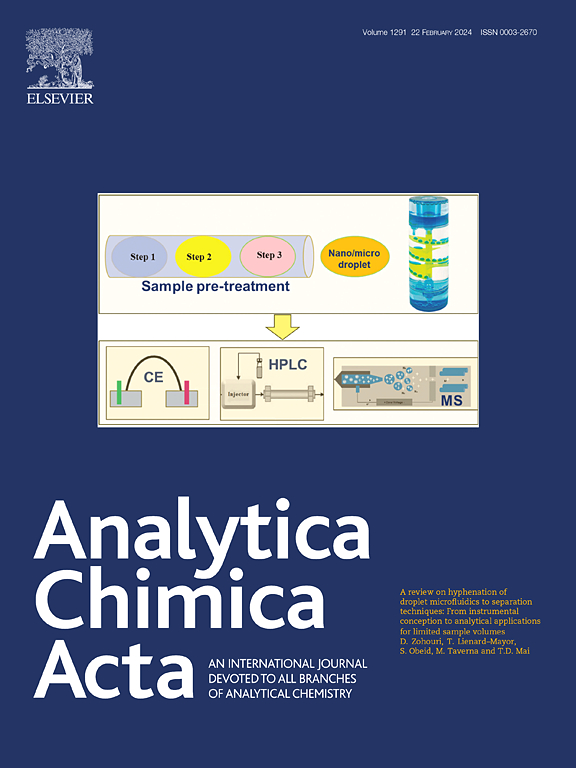Pd-modified MXene enabled electrochemical sensing platform for ratiometric detection of acetylcholinesterase inhibitors via modulation effect of Prussian blue
IF 6
2区 化学
Q1 CHEMISTRY, ANALYTICAL
引用次数: 0
Abstract
Background
Sensitive detection of acetylcholinesterase (AChE) inhibitors is crucial for pharmaceutical screening, managing neurodegenerative diseases, and drug development. However, their therapeutic use is often limited by toxicity and side effects. Current detection methods for AChE inhibitors suffer from issues like low sensitivity, high cost, and interference from complex biological matrices. Therefore, there is a growing and urgent demand for sensitive, reliable, and cost-effective sensors that enable early diagnosis, accurate monitoring of drug efficacy, and personalized treatment plans in various clinical settings.
Results
In this work, a novel ratiometric electrochemical sensor was developed using Pd-modified MXene integrated with Prussian blue (PB) nanocomposites for AChE inhibitor detection. The Pd-modified MXene provides high electrical conductivity and abundant surface sites for nanoparticle immobilization, enhancing electron transfer and signal strength. Pd nanoparticles improve the electrocatalytic activity of the electrode, boosting electron transfer. PB acted as a redox mediator that oxidized thiocholine (TCh), the enzymatic product of AChE-catalyzed hydrolysis of ATCh, and was reoxidized to generate a stable redox potential serving as an internal reference. This enabled dual-signal ratiometric detection, improving accuracy and resistance to background interference. Using berberine as a model inhibitor, the sensor exhibited a linear range of 0.13–41 μmol/L and a detection limit of 10.0 nmol/L. The sensor demonstrated excellent reproducibility, retaining 93.1 % of its initial response after 28 days, and detected berberine in tablet and serum samples with high recovery, showing broad applicability.
Significance
This work highlights the synergistic effects of Pd-MXene and PB, offering a portable, cost-effective strategy for highly sensitive AChE inhibitor detection. The dual-signal ratiometric detection system enhances both sensitivity and accuracy, making it ideal for biomedical and pharmaceutical applications, with significant potential for early diagnosis and monitoring of neurodegenerative diseases.


通过普鲁士蓝的调制作用,pd修饰的MXene电化学传感平台用于比例检测乙酰胆碱酯酶抑制剂
背景乙酰胆碱酯酶(AChE)抑制剂的敏感检测对于药物筛选、神经退行性疾病管理和药物开发至关重要。然而,它们的治疗用途往往受到毒性和副作用的限制。目前对乙酰胆碱酯酶抑制剂的检测方法存在灵敏度低、成本高、受复杂生物基质干扰等问题。因此,对敏感、可靠、具有成本效益的传感器的需求日益迫切,这些传感器能够在各种临床环境中进行早期诊断、准确监测药物疗效和制定个性化治疗计划。结果利用pd修饰的MXene与普鲁士蓝(PB)纳米复合材料结合,制备了一种新型的比例电化学传感器,用于AChE抑制剂的检测。pd修饰的MXene具有高导电性和丰富的表面位点,可用于纳米颗粒的固定,增强电子转移和信号强度。钯纳米粒子提高了电极的电催化活性,促进了电子转移。铅作为氧化还原介质,氧化巯基胆碱(TCh),即乙酰胆碱催化TCh水解的酶产物,并被再氧化产生稳定的氧化还原电位,作为内参。这使得双信号比例检测,提高精度和抵抗背景干扰。该传感器以小檗碱为模型抑制剂,线性范围为0.13 ~ 41 μmol/L,检出限为10.0 nmol/L。该传感器重现性好,28天后仍能保持93.1%的初始响应,对片剂和血清样品中小檗碱的检测回收率高,适用性广。本工作强调了Pd-MXene和PB的协同效应,为高灵敏度的AChE抑制剂检测提供了一种便携、经济的策略。双信号比例检测系统提高了灵敏度和准确性,使其成为生物医学和制药应用的理想选择,在神经退行性疾病的早期诊断和监测方面具有重大潜力。
本文章由计算机程序翻译,如有差异,请以英文原文为准。
求助全文
约1分钟内获得全文
求助全文
来源期刊

Analytica Chimica Acta
化学-分析化学
CiteScore
10.40
自引率
6.50%
发文量
1081
审稿时长
38 days
期刊介绍:
Analytica Chimica Acta has an open access mirror journal Analytica Chimica Acta: X, sharing the same aims and scope, editorial team, submission system and rigorous peer review.
Analytica Chimica Acta provides a forum for the rapid publication of original research, and critical, comprehensive reviews dealing with all aspects of fundamental and applied modern analytical chemistry. The journal welcomes the submission of research papers which report studies concerning the development of new and significant analytical methodologies. In determining the suitability of submitted articles for publication, particular scrutiny will be placed on the degree of novelty and impact of the research and the extent to which it adds to the existing body of knowledge in analytical chemistry.
 求助内容:
求助内容: 应助结果提醒方式:
应助结果提醒方式:


